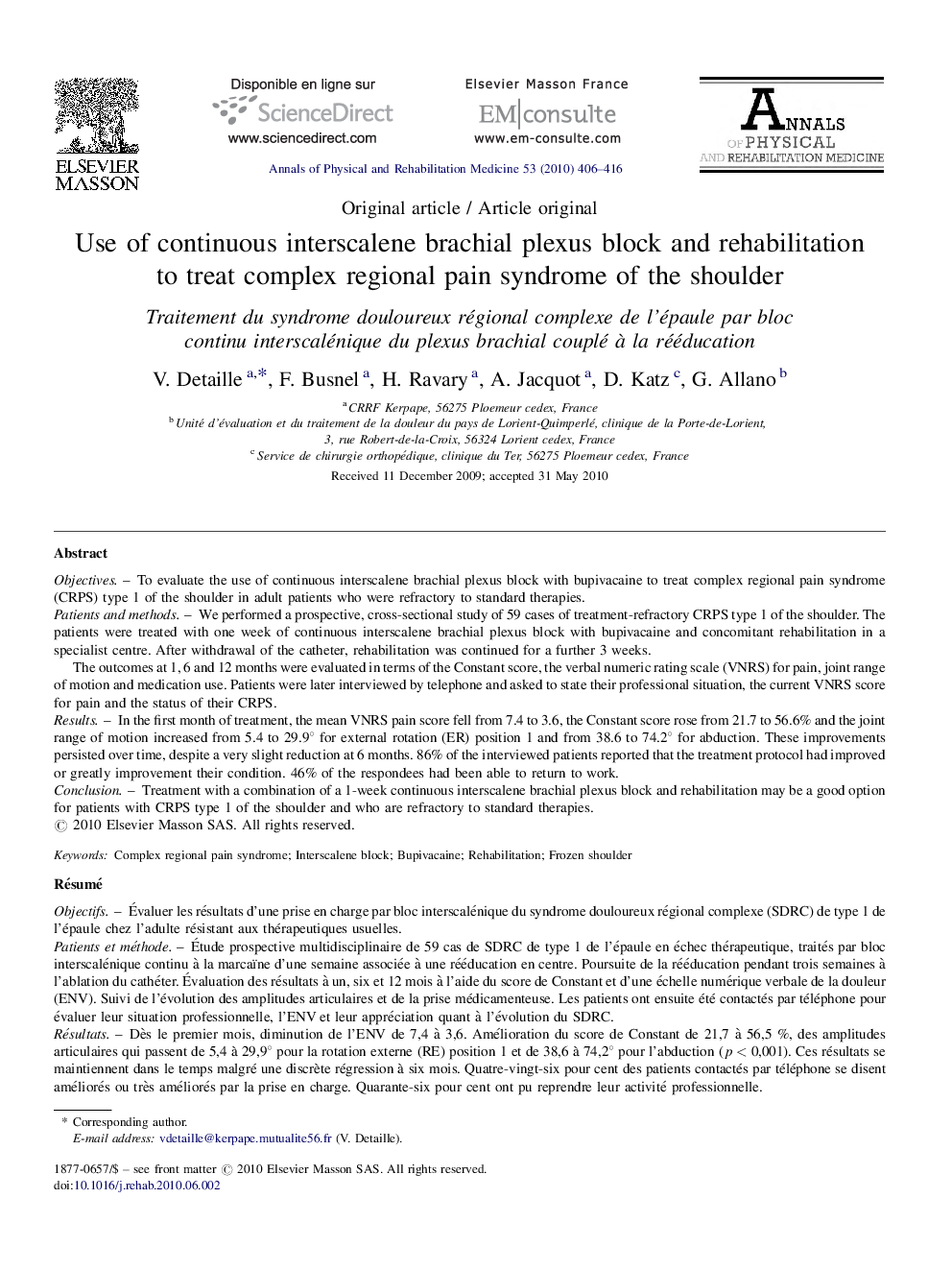| کد مقاله | کد نشریه | سال انتشار | مقاله انگلیسی | نسخه تمام متن |
|---|---|---|---|---|
| 6204388 | 1603345 | 2010 | 11 صفحه PDF | دانلود رایگان |

ObjectivesTo evaluate the use of continuous interscalene brachial plexus block with bupivacaine to treat complex regional pain syndrome (CRPS) type 1 of the shoulder in adult patients who were refractory to standard therapies.Patients and methodsWe performed a prospective, cross-sectional study of 59 cases of treatment-refractory CRPS type 1 of the shoulder. The patients were treated with one week of continuous interscalene brachial plexus block with bupivacaine and concomitant rehabilitation in a specialist centre. After withdrawal of the catheter, rehabilitation was continued for a further 3 weeks.The outcomes at 1, 6 and 12 months were evaluated in terms of the Constant score, the verbal numeric rating scale (VNRS) for pain, joint range of motion and medication use. Patients were later interviewed by telephone and asked to state their professional situation, the current VNRS score for pain and the status of their CRPS.ResultsIn the first month of treatment, the mean VNRS pain score fell from 7.4 to 3.6, the Constant score rose from 21.7 to 56.6% and the joint range of motion increased from 5.4 to 29.9° for external rotation (ER) position 1 and from 38.6 to 74.2° for abduction. These improvements persisted over time, despite a very slight reduction at 6 months. 86% of the interviewed patients reported that the treatment protocol had improved or greatly improvement their condition. 46% of the respondees had been able to return to work.ConclusionTreatment with a combination of a 1-week continuous interscalene brachial plexus block and rehabilitation may be a good option for patients with CRPS type 1 of the shoulder and who are refractory to standard therapies.
RésuméObjectifsÃvaluer les résultats d'une prise en charge par bloc interscalénique du syndrome douloureux régional complexe (SDRC) de type 1 de l'épaule chez l'adulte résistant aux thérapeutiques usuelles.Patients et méthodeÃtude prospective multidisciplinaire de 59 cas de SDRC de type 1 de l'épaule en échec thérapeutique, traités par bloc interscalénique continu à la marcaïne d'une semaine associée à une rééducation en centre. Poursuite de la rééducation pendant trois semaines à l'ablation du cathéter. Ãvaluation des résultats à un, six et 12 mois à l'aide du score de Constant et d'une échelle numérique verbale de la douleur (ENV). Suivi de l'évolution des amplitudes articulaires et de la prise médicamenteuse. Les patients ont ensuite été contactés par téléphone pour évaluer leur situation professionnelle, l'ENV et leur appréciation quant à l'évolution du SDRC.RésultatsDès le premier mois, diminution de l'ENV de 7,4 à 3,6. Amélioration du score de Constant de 21,7 à 56,5 %, des amplitudes articulaires qui passent de 5,4 à 29,9° pour la rotation externe (RE) position 1 et de 38,6 à 74,2° pour l'abduction (p < 0,001). Ces résultats se maintiennent dans le temps malgré une discrète régression à six mois. Quatre-vingt-six pour cent des patients contactés par téléphone se disent améliorés ou très améliorés par la prise en charge. Quarante-six pour cent ont pu reprendre leur activité professionnelle.ConclusionLe bloc interscalénique continu couplé à la rééducation peut-être une alternative thérapeutique pour les patients adultes présentant un SDRC de type 1 de l'épaule rebelle aux traitements usuels.
Journal: Annals of Physical and Rehabilitation Medicine - Volume 53, Issues 6â7, AugustâSeptember 2010, Pages 406-416